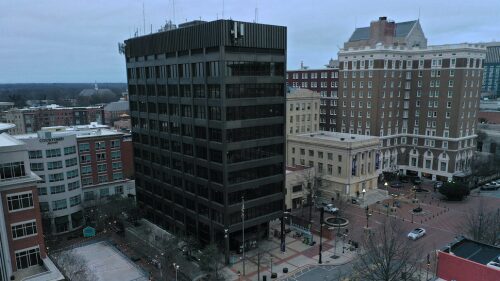The Dunean area is about to have its Renaissance. Plenty of new development is on the horizon – members of the Dunean Historical Society gave us all the details on what they love about their town, what sets the mill apart, and what to look for in the future.
#TBT to a century of history:
1911: Dunean Mill is chartered by Ellison Adger Smyth (a Civil War veteran + basically the godfather of Upstate textile mills), who helped organize ~20 mills total in the Upstate.
April 15, 1912: Dunean Mill officially begins operation with 50,000 spindles and 1,200 looms to produce high-quality cotton using only electricity. The modern design (which became a model for Southern mill construction) + state-of-the-art tech earned it the nickname “the million dollar mill.” 180 houses were constructed for mill village residents.

Dunean Mill Store in 1929 | Photo: Greenville County Historical Society Coxe Collection
Early 1920s: The mill doubled in size + added hundreds of new jobs and 270 new homes in the village. The houses’ electricity, sewer and water were all powered by the mill.
Mid 1920s: The village developed to include an elementary school, 3 churches, and a company store, community building, gym + baseball field. The area was designed with pedestrians in mind, with sidewalks connecting everything in town + streetcars available if you needed to leave the neighborhood.
1946: J.P. Stevens bought Dunean Mill (the largest mill in Greenville County at the time). Instead of the company owning the mill village homes, it began selling them to mill workers, meaning the residents became homeowners and services were no longer provided by the mill. This decentralized the town a bit, although the mill still maintained its baseball fields and some community buildings.
Late 1950s: The areas around Dunean began to develop, and mill village residents started upgrading their digs, taking the car to work instead of walking. Their village homes were taken over by non-mill workers, and the level of support from the mill decreased, meaning the town was even less centralized.
Mid 1960s: Most community organizations, churches, and businesses had become completely independent, and the mill was pretty much operating on its own. The mill village was more of a general residential area, and people were driving instead of walking. The community wasn’t as connected as it used to be – but the mill never closed, holding Dunean together.
Cut to 40 years later… 2005: The Dunean Historical Society was established. Beth Roddy + Marshall Williams, longtime Dunean residents, wanted to see the history of their town preserved and promoted. Look out for their two biggest events: the Annual Christmas Tree and Luminary Lighting + the Annual Memorial Day Celebration. They’ve also created a community vegetable garden, historical marker and memory walk, prayer labyrinth, veterans memorial plaque, and memorial garden.
April 15, 2012: Dunean celebrated its 100th anniversary, with the mill still operating, producing military/first responder/outdoor textiles for its new owner Safety Components. After celebrating Dunean’s history, it was time to start looking towards the future…
Here are the projects on the horizon that the Dunean Historical Society let us know about:
- G.A. developer Pace Burt (who’s redeveloped several historic spaces including Brandon Mill + Monaghan Mill) has purchased the old J.P. Stevens offices, which will likely become new office space + possibly artist studios. He’s also working with the Historical Society and Preservation South toward a National Historic Register District designation for Dunean.
- A row of old buildings on Smythe Ave. will be demolished to make way for a gated development (expected to be finished a year after demolition) with 7 brick-faced residential buildings, each featuring four 2 bed/2 bath units, 56 parking spaces + shared outdoor space.
- While J.P. Stevens will be renovated, there are plenty of original storefronts still standing on Dunean’s “Main Street” that would be perfect for entrepreneurs who want a spot with historic charm. One business that’s been in Dunean for decades has become a bit of a local legend – an old-school spot called Dunean Barber Shop (check out a video here).
The initiative driving this new development is the Dunean Community Plan, 50+ pages outlining the area’s past and how it can be protected, while still enhancing the community and adding some new life to a place that’s been part of Greenville history for more than a century.
The ten major community goals: promote Dunean’s history, improve its aesthetics, create a stronger sense of place, increase public amenities, create partnerships with local businesses, increase community interaction, decrease crime, create alternative modes of transportation, increase availability of public/private education, and explore opportunities for adult education + career advancement. (Each initiative has its time frame + specific execution outlined in the plan.) Dunean has big goals *and* citizens who are passionate enough about their home to make it happen.
















